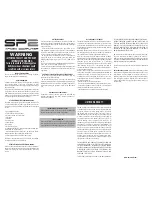
Page | 11
4
P
RINCIPLE OF MEASUREMENT
AquaPen is a fluorometer adapted for measurements of chlorophyll fluorescence parameters in liquid suspensions of algae,
cyanobacteria and isolated plant cells. Two versions of the AquaPen are available, the cuvette version (AP-C) and the probe version (AP-
P). Both versions are equipped with a
blue LED emitter
(455 nm for AP-C, 470 nm for AP-P)
. The cuvette version of the AquaPen also
has a red LED emitter (Fig. 3)
. These are optically filtered and precisely focused to deliver light intensities of up to 3,000 µmol.m
-2
.s
-1
.
Blue excitation light is intended for chlorophyll excitation, i.e., for measuring chlorophyll fluorescence in algal cultures and plant cell
suspensions. Red-orange excitation light is intended for excitation of phycobilins and is suitable for measuring in cyanobacterial
cultures
. The AquaPen
can detect chlorophyll levels down to 0.5 µg Chl/l
. Because of this high sensitivity it can be used for
measurements of natural water samples containing low concentrations of phytoplankton.
Chlorophyll fluorescence parameters measured by both versions of the AquaPen are F
t
, QY, NPQ, OJIP Analysis, Light Curve response of
QY. The cuvette version of the AquaPen (AP 110-C) also measures optical density at 680 and 720 nm.
To use measurements of chlorophyll fluorescence to analyze photosynthesis, researchers must distinguish between
photochemical
quenching
and
non-photochemical quenching
(heat dissipation). This is achieved by stopping photochemistry, which allows
measurements of fluorescence in the presence of non-photochemical quenching alone. To reduce photochemical quenching to negligible
levels, a high intensity, short flash of light is applied to the sample. This transiently closes all PSII reaction centers, and prevents energy of
PSII being passed to downstream electron carriers. Non-photochemical quenching will not be affected if the flash is short. During the flash,
the fluorescence reaches the high level in the absence of any photochemical quenching, known as
maximum fluorescence F
m
. The
efficiency of photochemical quenching (which is a proxy of the efficiency of PSII) can be estimated by comparing F
m
to the
steady yield of
fluorescence in the light F
t
and the yield of fluorescence in the
absence of photosynthetic light F
0
. The efficiency of non-photochemical
quenching is altered by various internal and external factors. Alterations in heat dissipation mean changes in F
m
. Heat dissipation cannot
be totally stopped, so the yield of chlorophyll fluorescence in the absence of non-photochemical quenching cannot be measured. See
picture below.
Fig. 2 Chlorophyll fluorescence.
Содержание AquaPen-C AP 110-C
Страница 1: ......
Страница 9: ...Page 9 3 DEVICE DESCRIPTION Fig 1 Device description...
Страница 13: ...Page 13 Fig 3 AquaPen C AP110 C Fig 4 AquaPen P AP 110 P...
Страница 22: ...Page 22 Fig 8 NPQ Protocol...
Страница 24: ...Page 24 Fig 9 LC1 Protocol...
Страница 25: ...Page 25 Fig 10 LC2 Protocol...
Страница 29: ...Page 29...
Страница 30: ...Page 30...
Страница 31: ...Page 31...
Страница 32: ...Page 32...
Страница 33: ...Page 33...
Страница 34: ...Page 34...
Страница 35: ...Page 35...
Страница 47: ...Page 47 Fig 26 Data export...
Страница 51: ...Page 51 Fig 34 GPS coordinates...












































